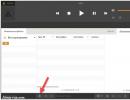Do-it-yourself strobe light for cars is the simplest. Do-it-yourself stroboscopes for cars
Owners of carburetor cars are familiar firsthand with the difficulties of the ignition adjustment process. This is usually done by ear, which is not very convenient. Using a strobe light this process can be made easier. However, industrial devices are quite expensive, so many people make a strobe light for ignition with their own hands.
Disadvantages of industrial models
Industrial devices often have certain disadvantages that make the usefulness of the device highly questionable.
To begin with, the price for them can be quite significant. For example, modern digital models will cost a car enthusiast 1000 rubles. More functional models cost from 1700. Advanced stroboscopes cost about 5500 rubles. Needless to say, a car strobe light (made with your own hands) will cost a car enthusiast 100-200 rubles.
Often in factory devices, the manufacturer uses a particularly expensive gas-discharge lamp. The lamp has a certain lifespan, and after some time it will have to be replaced. And this in itself is tantamount to purchasing a new factory device.
Why is it worth making a strobe light yourself?
The shortcomings of factory and technological devices push the car enthusiast to self-production this device. In addition, it is much cheaper to equip this equipment with LEDs instead of an expensive lamp. An ordinary laser pointer or flashlight is suitable as a source of diodes or a donor.
The remaining parts will also cost pennies. You don't need any special tools. The budget for the manufacturing process of a strobe light will be no more than 100 rubles.
How to make a strobe light with your own hands?
There are a huge number of schemes and options for manufacturing. However, for the most part, all projects to create this gadget are similar. Let's see what you need for assembly.

We will need a simple transistor KT315. It can be easily found in an old Soviet radio. The designation may be slightly different, but it doesn't matter. Thyristor KU112A can be easily obtained from the power supply of an old TV. You can also find small resistors there. Since we are making an LED strobe light with our own hands, we will naturally need LED flashlight. To do this, it is better to purchase the cheapest one from China. In addition, you need to stock up on a capacitor up to 16 V, any low-frequency diode, a small 12 A relay, wires, alligators, a 0.5 m long shielded wire, as well as a small piece of copper wire.
Assembling the device
The circuit is small, but you can place it right in that same Chinese lantern. So, it is advisable to pass wires through the hole in the back of the flashlight to power the device. It is better to solder crocodiles at the ends of the wires. You need to make a hole in the side wall, if the Chinese have not already made one. The shielded wire will be routed through this hole. At the opposite end, it is necessary to insulate the braid and solder the same piece of copper wire to the main core of the wire. This will be the sensor.
Device diagram and operating principle
Once current is applied through the power wires, the capacitor will charge very quickly through the resistor. When a certain charge threshold is reached, voltage will be supplied through the resistor to the opening contact of the transistor. The relay will work here. When the relay closes, it will create a circuit of a thyristor, an LED and a capacitor. Then, through the divider, the pulse reaches the control output of the thyristor. Next, the thyristor will open, and the capacitor will discharge to the LEDs. As a result, the strobe light, made with your own hands, will flash brightly.

Through a resistor and a thyristor, the base terminal of the transistor is connected to the common wire. Because of this, the transistor will close and the relay will turn off. The glow time of the LEDs increases, since the contact does not break immediately. But the contact will break, and the thyristor will be de-energized. The circuit will return to its base position until a new impulse is received.
By changing the capacitance of the capacitor, you can change the glow time. If you choose a larger capacitor, the DIY LED strobe will glow brighter and longer.
Device on a chip
The main part of this simple circuit is a DD1 type microcircuit. This is the so-called one-shot 155AG1. In this circuit, it is triggered only by negative impulses. The control signal will go to the KT315 transistor, and it will generate these negative pulses. Resistors 150 K ohm, 1 k ohm, 10 k ohm, as well as the KS139 zener diode work as amplitude limiters for the incoming signal from the car ignition.
A 0.1 mF capacitor together with a resistance of 20 kOhm will set the desired duration of the pulses that will be generated by the microcircuit. With such a capacitor capacity, the pulse duration will be approximately 2 ms.
Then, from the 6th leg of the microcircuit, the pulses, which by this moment will be synchronized with the ignition of the car, will go to the base terminal of the KT 829 transistor. It is here as a key. The result is a pulsed current through the LEDs.

How is this strobe light for cars powered? With our own hands we need to run a couple of wires to the terminals car battery. It is imperative to monitor the battery charge level.
If you put this together correctly simple diagram, you can immediately see how the device works. If suddenly the brightness is not enough, then this is regulated by selecting the appropriate resistance.
You can use an old or Chinese lantern as a housing for the device.
Another strobe light circuit
This LED strobe, made with your own hands according to this principle, can also be powered from a car battery. Diodes will provide protection against reverse polarity. An ordinary crocodile is used as fastener here. It needs to be attached to the high-voltage contact of the first spark plug on the engine. Next, the pulse will pass through resistors and a capacitor and arrive at the input of the trigger. By that time, this input will already be turned on by a one-shot device.
Before the pulse, the one-shot device is in normal mode. The direct trigger output has low level. The inverse input is, accordingly, high. A capacitor connected with a plus to the inverse output will be charged through a resistor.
A high-level pulse triggers a monostable, which switches the trigger and serves to charge the capacitor through a resistor. After 15 ms, the capacitor will be fully charged and the trigger will switch to normal mode.
As a result, the one-shot device will respond to this with a synchronous sequence of rectangular pulses with a duration of approximately 15 ms. The duration can be adjusted by replacing the resistor and capacitor.

The pulses of the second microcircuit are up to 1.5 ms. During this period, transistors are opened, which represent an electronic switch. Current then flows through the LEDs. A strobe light for a car works on this principle (whether it was made with your own hands or not does not matter - both devices shine the same way).
The current passing through the LEDs is much greater than the rated current. But, since the flashes are short-lived, the LEDs will not fail. The brightness will be enough to use this useful device even during the daytime.

This strobe light can be assembled with your own hands in the housing of the same long-suffering flashlight.
How to operate the device?
By assembling the device according to one of the given diagrams, you can simply and easily, and most importantly, accurately adjust the ignition on carburetor engines, check the correct operation of spark plugs and coils, and control the operation of the advance angle regulators.
To set the ignition as correctly as possible, it is usually assumed that the mixture is ignited a couple of degrees before the piston reaches the highest point. This angle is called the "lead angle". As the crankshaft speed increases, the angle should also increase. So, this angle is set at idle, and then it is necessary to check the correct setting in all operating modes of the unit.
Setting the ignition
We start and warm up the engine. Now we power our LED strobe and connect the sensor. Now you need to point the device at the mark on the timing case and find the mark on the flywheel. If the moment is broken, then the marks will be quite far from each other. By rotating the timing case, ensure that the marks match. When you have found this position, lock the distributor.

Then it's time to rev up. The marks will diverge, but this is a completely normal situation. This is how the ignition is set up using a strobe light.
So, we found out how to make a LED strobe with your own hands.
Many car owners would like to drive down the street at high speed with the special lights on. signals thereby attracting people's attention. But this pleasure is allowed only to a few, and the use of flashing lights and other special equipment in full view of mere mortals is subject to a heavy fine. But these are just formalities, and having strobes and using them correctly is not prohibited. In connection with this idea, the idea arose to construct simple strobes. The only difference between this type of stroboscopes is their absolute simplicity in manufacturing and the availability of assembly elements.
A short assembly video:
For the device you will need:
- 2 turn relays – 494.3787 (used in GAZ-3110, GAZ-33021 “Gazelle”, GAZ-2752 “Sobol”)
- 2 variable resistors with a nominal value of 20 KOhm (the flash speed will be high) or 470 KOhm (the flash will be a little slower).
- 1 five-pin automotive relay 983.3777-01 (98.3777, 903.3747-01, constant 984.377, 90.3747)
Assembly.
First you need to disassemble the turn relay and unsolder the resistor (it is shown in the photo) and solder a variable resistor instead. (Since the variable resistor has three legs, it is necessary to solder the central leg to one of the side legs)
For the second relay you also need to do the same procedure.
- Advice! It is recommended to remove all variable resistors - since these elements regulate the flash speed of LEDs or light bulbs and the speed of switching between each other (stroboscopes).
The best option– connecting the circuit to the DRL.
A simple circuit for stroboscopes.
- PC 5 is a simple five-pin relay.
But it is recommended to assemble the diagram that is presented below. Making it, of course, is a little more complicated, but here you can easily switch from using daytime running lights to strobe lights.
- R1, R2 – variable resistors;
- PC 5 – simple five-pin relay
- RP1, RP2 – turn relay 494.3787
 Automotive throttleless power supply based on IRS2153 for laptops and mobile phones Device for monitoring the operation of the direction indicator Do-it-yourself heated steering wheel in a car Security sensor for gas tank
Automotive throttleless power supply based on IRS2153 for laptops and mobile phones Device for monitoring the operation of the direction indicator Do-it-yourself heated steering wheel in a car Security sensor for gas tank
The process of adjusting the initial ignition timing is greatly simplified when using special devices. Their work is based on the stroboscopic effect. The meaning of this physical phenomenon is as follows: if you illuminate a moving object with a short flash of light, a visual illusion will arise that it remains in the same position in which this flash caught it.
Making your own LED strobe is very simple. There are diagrams of simple devices that even an inexperienced radio amateur can repeat.
LED strobe on timer NE555
The main component in this strobe circuit is the NE 555 integrated timer. This is a common chip often used in electronic homemade products.
Used as a light emitter ready assembly of six LEDs from a Chinese lantern.
Strobe circuit on NE555 timer
Potentiometer P1 sets the pause time between pulses, which are supplied to VT1. Opening when the signal is given, field-effect transistor The strobe lights up.
It should be taken into account that at the moment of flash, the current passing through the emitter exceeds two amperes. This circumstance forces the use of a limiting resistor with a power dissipation of at least 2W. There is no reason to worry about LED failure. Ultra-short operating times in such modes will not cause damage to semiconductors.
Instead of the transistor indicated in the diagram, you can use its closest analogues: IRFZ44, IRF3205, KP812B1 and others.
The requirements for the VD1 diode are high performance. 1N4148 is being successfully replaced by the domestic version KD522. Any Schottke diodes will also work well.
The capacitance of capacitors can be increased by one order of magnitude. This will not affect the performance of the circuit in any way.
This is what the assembled device looks like, with three high-power LEDs.
 Stroboscope assembly
Stroboscope assembly A small number of parts allows you to make a strobe from LEDs using the hinged method or using special mounting panels. If no errors are made during the soldering process, the circuit will work immediately, without additional adjustment.
Another variation of assembling a do-it-yourself car strobe light on LEDs is based on the TL494 PWM driver. The cost of the microcircuit is in the range of 10 - 20 rubles per piece, so it cannot be called scarce. In addition, you can remove the required component from an old ATX power supply from personal computer.
 LED strobe circuit on a TL494 PWM controller
LED strobe circuit on a TL494 PWM controller As in the previous case, the emitter is controlled by a MOSFET transistor. Here it can be of any type that meets two requirements:
- Rated current – from 2A;
- internal structure is N-type.
Examples of suitable field workers: AP15N03GH or IRLZ44NS.
Trimmer resistor VR1 sets the duty cycle (duration of flashes), and VR2 sets their frequency. It is more convenient to use potentiometers with linear dependence, this makes the setup process much easier.
The light source in this strobe circuit is one powerful LED. To connect 12 volt LED strip, resistor R6 must be removed by installing a jumper instead.
The remaining elements of the LED strobe circuit can be anything with the specified ratings.
Device circuit board
The size of the structure can be minimized using SMD components. Some novice radio amateurs try to avoid using them, believing that installing small parts is too labor-intensive. And in vain! A little practice will help you cope with this task without difficulty. But the result will be an excellent reward for your patience.
Sample implementation printed circuit board LED strobe is shown in the figure.
 Sample printed circuit board for a strobe light
Sample printed circuit board for a strobe light
A two-way wiring method is used here. Large radio elements are installed on top: a microcircuit, terminal blocks and electrolytic capacitors, on the bottom resistors and capacitors of size 1206, LEDs of size 0805, a MOSFET transistor in a DPAK package. Regulating resistors have been replaced with trimmers. This was done to reduce the size of the structure.
The appearance of the board of the finished device from both angles is presented below. To transfer a pattern with tracks onto foil-textolite, the LUT method was used. Etching was carried out in aqueous solution ferric chloride.

If you want to repeat the LED strobe circuit with your own hands, you can use the project for the Sprint Layot tracer, changing it if necessary to suit your own needs. .
The consideration in the article of stroboscope circuits is distinguished by their simplicity and low cost of electronic components. The total cost of materials will cost tens of times less if you purchase a ready-made LED strobe. In addition, using a homemade device is much more pleasant, and the experience gained in the process of work is irreplaceable and priceless.
I found a solution on how to make the simplest stroboscopes with my own hands, maybe someone will tell you why this is needed... but not everyone is like that, maybe on the contrary someone is looking for just such a scheme, but one way or another I still decided to post such a scheme, especially , What simpler option you're unlikely to find it. So what we need:
two turn relays 494.3787
two 20K Ohm variable resistors.
one five-pin simple automotive relay.
Now we take the turn relay, disassemble it and find a resistor (it is indicated in the photo), unsolder it and solder in a 20 Kom variable resistor instead.
We do the same with the second relay. Of course, it is better to place the resistors later in a place convenient for you, since with them you will regulate the speed of flashes of light bulbs or LEDs (fog lights or DRLs) and the speed of switching between each other (right and left lights). The best option is of course to connect this diagram to DRL.
Here's a simplified version of the diagram...

R1, R2 - variable resistors
But it’s better, of course, to make a circuit like this (below), a little more complicated, but on it you can use daytime lights, and when you need to switch to strobe lights, you just turn on the switch and that’s it.

R1, R2 - variable resistors
RP1, RP2 - turn relay 494.3787
PC5 - simple 5-pin relay (starter type)
Well, here's a short video...
A stroboscope is a very familiar device that has found quite wide application in many branches of science and technology. A simple example of a strobe light is police flashing lights. Such flashing lights are considered a special signal and their use is illegal. But despite this, some adventurers who are looking for adventure on their own are accustomed to using illegal things to distinguish themselves from others. To be honest, I consider myself one of them, so I decided to make a “MENT” strobe light with my own hands and will share the diagram with you.
LED strobe circuit
Of all the schemes that can be found on the Internet, this one the simplest and fully working. Let me remind you that such a strobe differs from a simple flasher in that there you can set the blinking frequency and the number of LED flashing sequences. Simply put, each LED blinks 2, 3 (up to 4 times), then switches and the second LED starts blinking. It turns out to be a complete analogue of police stroboscopes, which are best used in the remote surroundings of your area, otherwise you will face a hefty fine for using a special signal.

The strobe circuit does not contain an MK. The master oscillator is everyone's favorite timer 555. The CD4017 counter has a domestic analogue (K561IE8). This is a decimal counter-divider with 10 decrypted outputs.
The signal from the outputs of the microcircuit is amplified by transistor switches; there is a very wide choice. If you are going to connect LEDs, then you can eliminate transistors altogether, to power more powerful LEDs or LED assemblies You can use any LF bipolar transistors - KT819/805/805/829, etc.

You can connect more powerful lamps to the strobe, for example, halogen lamps from car headlights with a power of 100 watts or more. To do this, you just need to use powerful field switches IRFZ44, IRF3205, IRL3705, IRF1405 and other N-channel power transistors of appropriate power.
The strobe light was mounted in a housing from an electronic transformer; the housing simultaneously serves as a heat sink for the transistors, although no overheating was observed on them.

Such a homemade strobe can work for hours; the circuit does not require additional adjustment and works immediately after switching on. The device is powered from the car's on-board network of 12 Volts, although it starts working from 6 Volts.
Video of a homemade strobe light in action:





